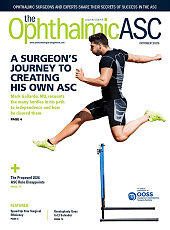Ashvattha Therapeutics announced interim results from its ongoing phase 2 study of subcutaneous (subQ) migaldendranib (MGB) for the treatment of diabetic macular edema (DME) and neovascular age-related macular degeneration (wet AMD). The data were presented at the MaculArt Meeting, June 29-July 1, 2025, in Paris.
MGB represents a potential alternative to current standard of care, and is a first-in-class subcutaneously administered candidate being developed for at-home monthly treatment of DME and wet AMD, the company said in a press release.
According to Ashvattha Therapeutics, subcutaneously (subQ) administered MGB provides a unique mechanism of action of normalizing vascular endothelial growth factor (VEGF) expression in activated macrophages, microglia and retinal pigment epithelial cells in the retina. By reducing VEGF expression, MGB reduces the need for anti-VEGF intravitreal injections improving patient adherence.
Data presented in the presentation titled "Subcutaneous Migaldendranib (MGB) for the Treatment of Neovascular Age-Related Macular Degenerations and Diabetic Macular Edema: Interim Results of Chronic Dosing Phase 2 Study" showed that subQ MGB demonstrated promising safety and tolerability in both DME and wet AMD patients in the first 24 weeks of treatment. According to the company, the study used more conservative supplement criteria compared to other recent clinical studies, with rescue anti-VEGF injections given when central subfield thickness increased above baseline, rather than the >75 μm increase from lowest value used in other studies. The interim analysis included 19 subjects who completed 24 weeks
(11 wet AMD, 8 DME).
Results from the study revealed the following:
-
DME patients exhibited an increased best-corrected visual acuity (BCVA) of +4.5 letters and a decreased central subfield thickness (CST) of -69.1 µm, with an observed reduction in treatment burden by 80%
-
Wet AMD patients maintained stable mean BCVA and CST for 24 weeks with +3 letters, -45.5µm CST and a comparable 79.9% reduction in treatment burden
-
Notably, fellow eye results also showed substantial treatment burden reduction of approximately 75% compared to pre-treatment, demonstrating the potential bilateral benefits of subcutaneous administration
-
Safety findings included injection site reactions in 8.6% of injections administered, which were localized, transient and mostly mild.
According to Ashvattha Therapeutics, these interim results support MGB’s potential in decreasing the need for supplemental intravitreal injections of anti-VEGF, suggesting a potential new treatment pathway for patients. End of study results will be presented at an upcoming conference, the company said.








